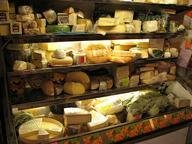Quiz Answer Key and Fun Facts
1. First things first -- what is the ideal type of milk to use for cheesemaking?
2. What specialized equipment do you need to begin making cheese?
3. What are the basic ingredients in cheese?
4. What method is best to use to determine when you should cut your curd?
5. What temperature is it best to age cheese at?
6. Why are some cheeses washed with water during the cooking process?
7. You have just completed your first Caerphilly. You used raw milk and the milled curds tasted wonderful! Pressing went like a dream and you found just the right size tupperware to make a minicave for it in your wine cooler. Now, a week later, you check on it and find that it is covered with a fine, half inch long gray shag carpet of mold. What do you do?
8. What is the best rind treatment to use for a true cheddar type?
9. What mold(s) is/are typically associated with brie and camembert types?
10. And lastly, after affinage is complete -- what is the best thing to do with the leftovers, if you can't eat them all at once?
Source: Author
KMarieJ
This quiz was reviewed by FunTrivia editor
WesleyCrusher before going online.
Any errors found in FunTrivia content are routinely corrected through our feedback system.

